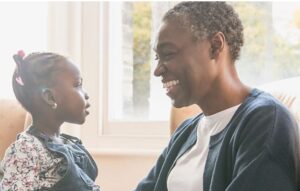Early communication
Early communication
 There are a variety of techniques you can access below that will support you to help a child or young person begin to communicate, so that they can:
There are a variety of techniques you can access below that will support you to help a child or young person begin to communicate, so that they can:
- understand language used by others about daily routines
- develop their ability to express their ideas and choices
- enjoy and develop interactions with others.
You will also find videos below demonstrating how parents have found successful ways to communicate with a non-speaking child.
-
What is Makaton?

Using visual signs can be useful for children who have no speech (because they have communication difficulties or are very young), or whose speech is unclear. Signing can help to empower children to communicate what they want to say, reducing frustration.
Makaton can help children and young people who have difficulty with:
- listening to and understanding speech
- communicating what they want, think, or how they feel
- making themselves understood
- paying attention.
Helpful information and resources:
-
 What is intensive interaction?
What is intensive interaction?Intensive Interaction is an approach that supports interaction and learning in the early stages of communication development. It is a fun and enjoyable way to help develop communication using a variety of techniques to engage the child or young person and encourage them to interact and vocalise.
This helps children to develop the fundamentals of communication – the abilities and experiences that come before speech development.
The fundamentals of communication
The fundamentals of communication include:
- Enjoying being with another person and sharing personal space.
- Developing the ability to show attention to that person.
- Learning to take turns in sequences of actions with another person.
- Using and understanding eye contacts, facial expressions and body language.
- Using vocalisations with meaning (for some, speech development).
- Learning to feel and be calm.
How do I interact intensively with my child?
You interact with your child by watching, waiting and tuning in to what they are doing, seeing what they’re interested in and trying to enter their world by:
- following your child’s lead
- not doing too much
- letting your child’s play, movements and vocalisations guide you
- responding to what they’re doing by copying and joining in
- making your voice and face look warm, exciting and interested in what they are doing.
You don’t need lots of toys for intensive interaction as you can use your facial expressions, sounds and movements. However, some things that might be useful include balls and ball runs, cars and car ramps, bubbles, mirrors, balloons, light and sound toys, sensory materials like feathers or brushes.
How to get started with intensive interaction
- Spend some one-to-one time with your child.
- Put yourself in a position where you are close to your child.
- Keep your face relaxed and interested.
- The important bit: tune-in to what your child is doing with their body and their sounds.
- Take time to watch.
- Slowly begin to copy and join in with what your child is doing.
- Go slowly and use lots of pauses. Your child may begin to notice you are doing the same thing.
- The main aim is that both you and your child enjoy your time together and have fun.
Helpful ideas for intensive interaction
- Imitation – copying what your child does by repeating their sounds and actions.
- Doing things together – look at and explore objects together by passing objects or toys back and forth, looking in a mirror together, making noises together, playing with a ball, watching bubbles, singing songs with actions.
- Eye contact and facial expressions – you can do this by playing games like peek-a-boo, pulling faces, or looking in the mirror together. You could do facial expressions like smiles, frowns, silly faces, tongue movements, yawns, or sneezes.
- Building anticipation – start an activity then leave a pause to give space for your child to anticipate and react. For example, say “ready, steady… go!” with a long pause in between steady and go for your child to make a physical movement, eye contact or sound. Ideas for anticipation building games include bubbles, tickling, chasing, letting toy cars run down a ramp, songs with actions, blowing up balloons.
It’s really important to follow your child’s lead and use objects and toys that interest them.
Useful information and resources for intensive interaction
Autism, Social Communication, Intensive Interaction
Therapy strategies: Intensive Interaction
-
The ‘Objects of Reference’ approach can be used for children and people in the early stages of communication development to support an understanding of daily routines, an understanding of spoken language and communication of choices.
What is an object of reference?
Objects of reference are objects that represent a person, thing, place or activity.
They need to be easy to carry and to clean. They should not be something that is needed as part of your activity or routine – they indicate that the activity or routine is about to happen.

Outside
A football can be used as an object of reference to indicate outside

Bathtime
A sponge of any kind can be used as an object of reference to indicate bathtime

Mealtime
A spoon of any kind can be used as an object of reference to indicate mealtime.
When should I use an object of reference?
You can use an object of reference with a child or young person who does not yet understand words, pictures, or symbols to help them be aware of what is happening.
Some children and young people learn to use objects of reference to choose what they want to do.
Using objects of reference in the early stages of communication development can support an understanding of daily routines and spoken language as well as help to communicate choices.
How to get started using objects of reference
Use three to five objects to start with and link them to things that you do
every day with your child – for example, going outside, a favourite activity, mealtimes or seeing a favourite person. You will need to:- Show the Object of Reference right before the activity.
- Let your child hold it if they can.
- Use a word or phrase e.g. ‘it’s dinner time’.
- Show them the person, object, place or activity.
- Put the Object of Reference away when the activity is happening or has finished.
- Allow time for children to learn what objects of reference mean
More resources
This leaflet from South West Yorkshire NHS talks in more detail about the different stages and dos and don’ts of using Objects of reference
This helpful video talks about how to use ‘normal visual cues’ as clues or ‘objects of reference’
-
What is Echolalia?
 One way a child learns language is by repeating what you say and what they hear around them. This is called echolalia.
One way a child learns language is by repeating what you say and what they hear around them. This is called echolalia.In the early stages of communication development children and young people may repeat the exact phrase you’ve said – for example, “What do you want for lunch?” when they are hungry. Or it might be phrases they’ve heard from their favourite cartoons, films, or YouTube clips.
The BBC’s Tiny Happy People website has more information about echolalia and things you can do to support a child or young person who uses echolalia to communicate.
You may also find these four tips for children who communicate with delayed echolalia useful.
